By Lambert Strether of Corrente.
Amazon built a warehouse in Tornado Alley, did not build in sufficient protection for workers, denied workers the ability to protect themselves, and is already scheming to cover up its act of social murder.
I’ll prove these four claims in short order, but first, let’s look at how we classify tornados, because we’ll need that to interpret the coverage and the maps that follow. Tornadoes were classified according to the Fujita Scale (F), which was upgraded to the Enhanced Fujita Scale (EF). Here is a chart describing them:
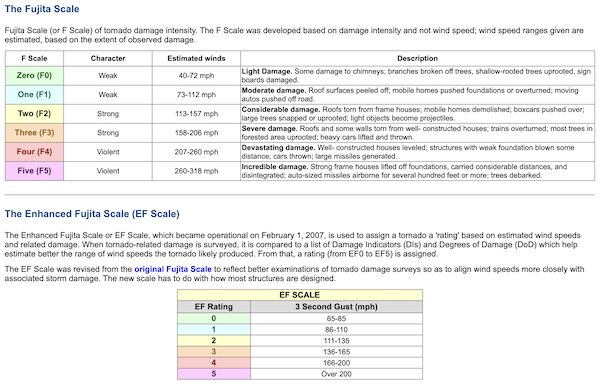
The National Weather Service describes the Edwardsville tornado and classifies it as EF-3:
A strong tornado touched down just to the northeast of the I-270/I-255 interchange at 8:28 PM CST. The tornado moved northeast and intensified rapidly after crossing I-255, striking an Amazon warehouse. The west-facing walls of the warehouse collapsed inward, which was followed by multiple structural failures as the tornado moved through the complex, including the collapse of additional walls and the loss of a large segment of the roof. This was the worst damage along the entire tornado track rated EF-3.
Estimated peak winds were 150 mph. You will note that EF-3 isn’t even the most powerful tornado. Mapping back to the F scale by wind speed, the Edwardsville tornado would be classifed as “considerable damage,” and not as “severe”, “devastating”, or “incredible” (!!) damage.
And yet the Edwardsville tornado, fourth on a scale of six, inflicted damage on the Edwardsville Amazon warehouse like this:
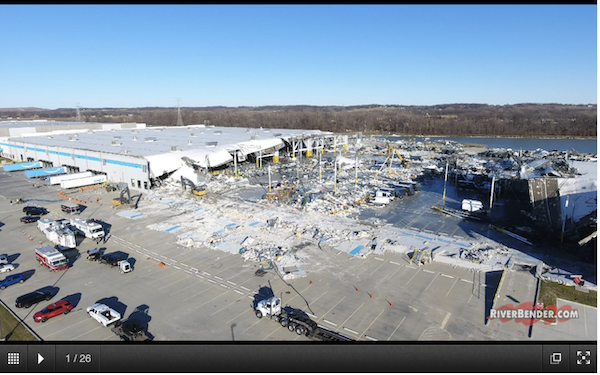
“Considerable,” indeed. The tornado moved right through the warehouse, sparing the north bays, but destroying the south. (North vs. South will become important shortly, when we look at where the deaths took place.)
Amazon Built Its Edwardsville Warehouse in Tornado Alley
The Belleville News-Democrat explains why Amazon sited its warehouse there:
Madison County’s flat, empty land and proximity to interstates, airports, rail and river travel made it an appealing location for the e-commerce giant.
That Edwardsville was in Illinois’ tornado alley did not, apparently, figure largely in Amazon’s plans. From the Midwestern Regional Climate Center:
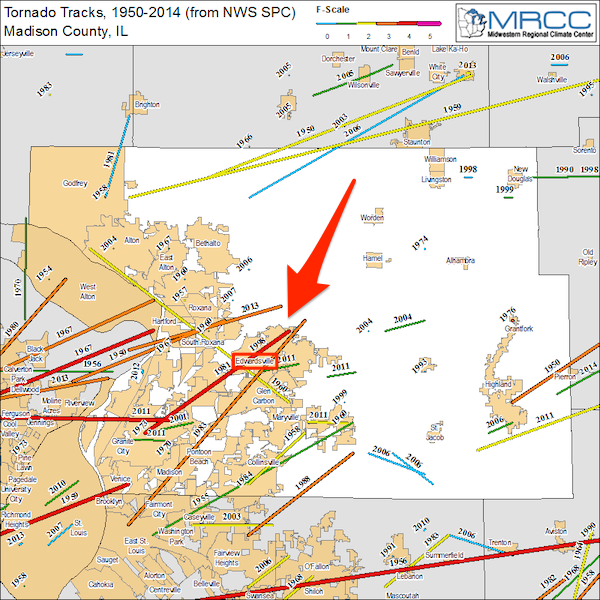
As you can see, Edwardsville experienced F4 tornadoes in 1991 and 1998, and F3 tornadoes in 1983 and 2011. So the Amazon warehouse has in the crosshairs, and a tornado strike was only a matter of time. One would assume that Amazon would take every measure possible to protect its workers, but sadly, no.
Amazon Did Not Build in Sufficient Protection for Workers
There are three issues with how Amazon built its warehouse. Lack of a basement shelter, tilt-up wall construction, and bathroom storm shelters. Let’s take each in turn.
No basement shelter. As any child in flyover knows — or anybody who’s seen The Wizard of Oz — the safest way to shelter from a tornado is underground, in a cellar. That was not possible in Edwardsvlle. From the Edwardsville Intelligencer:
The Amazon building does not have a basement, which could have offered employees additional shelter.
“As I understand, the challenge here is flooding. You can’t dig very far down before you (reach water),” [Illinois Gov. J.B. Pritzker] said. “That’s why they don’t allow basements in the industrial area here.”
Presumably, Amazon felt it could offer workers equivalent protection above-ground (unless commercial considerations prevailed, of course).
Tilt-up wall construction. Alert reader Mark Sites describes this construction technique in comments:
The Amazon warehouse appeared to be standard tilt-up construction, the most often used form of construction for big boxes. The the concrete panels are formed on the ground, like a tall skinny rectangle. When the reinforced concrete has reached the needed strength a crane is used to tilt the panels up and ‘stack’ them along the exterior steel frame. The steel framing of the building is what carries the wind loading on the walls. Construction is covered under national and local building codes, which do include wind loads for both walls and roofing, and the procedures for analyzing them.
(I will look into code issues in an Appendix.) If you look back at the picture of the post-tornado warehouse above, you will see the steel framing still standing, amidst the rubble of the walls and the roof. A similar event happened to a Home Depot, a big box like the Amazon warehouse, in Joplin, MIssouri, in 2011. From the Wichita Eagle:
Under high winds, the roof can become compromised, and the panels in tilt-up wall buildings can fall like dominoes, said Larry Tanner, a tornado expert and part of a team of engineers who traveled to Joplin to study the Home Depot collapse and other building failures for the Federal Emergency Management Agency.
“Once you lose one (wall) panel, then the dominoes all start to fall, so the failure becomes increasingly more catastrophic,” Tanner said. “I was aghast at how extensive Home Depot’s failure was.”
If the building code had required the Home Depot store to have stronger roof-to-wall connections, it might have sustained less damage, even in such heavy winds, said Tanner and other engineers interviewed by the Star.
“It’s an efficient and low-cost building system, but it’s only stable when all the connections are working,” said Perry Adebar, an engineer who studies tilt-up wall designs at the University of British Columbia. “It’s a bit of a house of cards.”
The Tilt-Up Concrete Association also produced a report on the Joplin disaster, in 2012. It includes this recommendation:
Recommend to ICC and direct to building owners the use of storm shelters in lieu of designing buildings for high winds. The TCA should develop specific Tilt-Up based storm shelter designs for winds of up to 200 MPH that would compete against alternative masonry, precast, or cast-in-place designs. Storm shelter design is addressed in 2009 IBC, section 423 and ICC-500.
This implies to me that no Tilt-Up warehouse can withstand a tornado (at least of EF-3 or above. It’s also fair to say that the TCA doesn’t think much of the Wichita Eagle, but given that recommendation, I think the Eagle got the big picture right. So far as I know, that recommendation has never been implemented, by the ICC or anyone else. This brings us to the shelters Amazon actually built.
Bathroom storm shelters. I’ve noticed a dearth of reporting from the majors on how the workers — those who survived, and those who died — actually sheltered. Fortunately, there is local coverage. Here are two accounts from the south side of the warehouse, where the deaths took place. From KMOV, quoting Amazon worker Craig Yost:
“They’re telling people just park your van and go to the shelter,” he said. “Where’s the shelter? The bathrooms? Okay, so I parked the van and go to the bathroom. They had people directing others to the bathroom, and that’s where we sat and waited.”
And then:
“The walls caved in, and I got pinned to the ground by a giant block of concrete,” said Craig Yost. “I was pinned down on my left hip with my right hip and my right shoulder holding a chunk of concrete. On top of my left knee was a door from the bathroom stall, and my head was on that with my left arm wrapped around my head. I could just move my right hand and foot.”
From the Norman Transcript:
When the weather started turning bad, [Jaeira Hargrove and Etheria Hebb] returned and quickly parked their vans. A woman told them to head to the bathroom because of a tornado warning.
Growing up in the St. Louis area, they’d been through warnings before but neither thought they would ever be hit by a tornado, Hargrove said.
They walked to the bathroom, not in a panic.
And then:
“We were just standing there talking. That’s when we heard the noise. It felt like the floor started moving. We all got closer to each other. We all started screaming,” Hargrove said.
Were the bathrooms, as the TCA recommends, “shelter designs for winds of up to 200 MPH”? Clearly not, since winds of 150 mph caused the bathrooms on the south side to collapse, killing people. Bloomberg reports:
One person familiar with Amazon’s warehouse construction said the buildings are designed to local standards that account for events such as severe storms and snow loads. Warehouses in tornado-prone areas include space that is more heavily reinforced with extra steel and concrete where workers are instructed to huddle in event of emergencies, he said.
It would be useful if there were some actual on-the-ground reporting to see how Amazon had those bathrooms constructed. Clearly, the extra steel and concrete, if any, didn’t do the job. Quartz reports:
Amazon did not respond to questions from Reuters about whether its facility’s bathrooms were the designated shelters for tornado emergencies.
It doesn’t matter what Amazon says. We know what the workers said. More:
It was also unclear if the number of bathrooms on the site was sufficient to protect even the 50-plus employees known to be at the site. Amazon has a notorious record of providing fewer bathrooms than necessary for its staff, and for instituting such punishing work schedules that employees relieve themselves in bottles rather than take bathroom breaks.
[I’ve omitted a bunch of Amazon blather from spokesholes at corporate. It’s clear that they’re either lying, or don’t know anything about the material conditions at this particular warehouse.]
Amazon Denied Workers the Ability to Protect Themselves
Amazon did this in at least two ways. First, through poor training. Second, by denying workers cellphones. Let’s look at each of these.
Poor training. From The Intercept:
[A] concern expressed by a dozen Amazon employees who spoke about the lack of workplace safety afforded to workers across the country — not just related to extreme weather events but to hazards in general. Many workers, all of whom requested anonymity to protect their jobs, said they had never had a tornado or even a fire drill over the course of their careers at Amazon, dating back up to six years. Several expressed that they would be unsure of what to do in an emergency. In one case, an Amazon contractor, fearing Hurricane Ida, asked to go home early but was told that leaving would adversely affect their performance quota.
Certainly the vivid description of Amazon straw bosses shouting at workers to head for the bathrooms gives a picture of a training regimen that has been inconsistently, not to say spottily, applied. (And if the workers are contractors, so what?)
No cellphones. From Bloomberg:
An Amazon spokeswoman said company policy currently allows all Amazon employees and delivery drivers to have access to their phones during their shifts. But several workers in different states told Bloomberg their managers had already resumed the ban.
One person whose job entails training new hires said some managers began banning phones to see if doing so caused absenteeism to spike or employees to complain. The people spoke on condition of anonymity because they’re not authorized to speak with the media.
Although the reporting on conditions at Edwardsville is spotty, it does seem that managers were, well, “working toward the Bezos” on cellphone policy:
Five Amazon employees, including two who work across the street from the building that collapsed, said they want access to information such as updates on potentially deadly weather events through their smartphones — without interference from Amazon. The phones can also help them communicate with emergency responders or loved ones if they are trapped, they said.
Indeed, Amazon seems like a pretty schizophrenic company. They can’t train or protect their workers, but they’re brilliant with technology:
Amazon can
track every milisecond a worker is “off task”
use heat maps to prevent workers organizing
monitor how many times a driver blinks
But says it can’t
tell rescuers how many workers were there and need to be searched for
Yeah right #AmazonTornado
— ResistHere (@ResistHere) December 12, 2021
Amazon Is Already Covering Up
From the Intercept:
The company took an additional step yesterday by encrypting internal help ticket messages about the Illinois facility, making them inaccessible to most workers, according to an employee who provided screenshots before and after the messages were encrypted. Amazon did not respond to a request for comment on why the records had been encrypted.
One can only wonder why. More:
The messages revealed a communication breakdown in which corporate failed to notify employees about the tornado even as it happened. “Corporate and IT were troubleshooting network outages and found out the building was hit by a tornado from the media,” said the employee who provided the communications. “What the correspondence showed was that initially, nobody knew what was happening. More and more people joined in on the tickets to troubleshoot the issues only to find out from the media that the building was hit by a tornado.”
The narrative was “absolutely heartbreaking,” the employee added. “It looks like they had almost no warning.”
Conclusion
Friedrich Engels coined the phrase “social murder” in 1845. It’s still germane today! From “The Condition of the Working Class in England“:
When one individual inflicts bodily injury upon another such that death results, we call the deed manslaughter; when the assailant knew in advance that the injury would be fatal, we call his deed murder. But when society places hundreds of proletarians in such a position that they inevitably meet a too early and an unnatural death, one which is quite as much a death by violence as that by the sword or bullet; when it deprives thousands of the necessaries of life, places them under conditions in which they cannot live – forces them, through the strong arm of the law, to remain in such conditions until that death ensues which is the inevitable consequence – knows that these thousands of victims must perish, and yet permits these conditions to remain, its deed is murder just as surely as the deed of the single individual; disguised, malicious murder, murder against which none can defend himself, which does not seem what it is, because no man sees the murderer, because the death of the victim seems a natural one, since the offence is more one of omission than of commission. But murder it remains.
That Amazon found out its warehouse had been destroyed by a tornado because corporate was troubleshooting a network outage…. Well, that pretty much sums up an offence by omission. These executives were very different from Amazon worker Clayton Cope, who gave his life trying to save others.
At this point, we recall that the NLRB gave the Retail, Wholesale and Department Store Union a do-over in its attempt to organize workers at Bessemer, AL because Amazon — hold onto your hats here, folks — cheated. Alabama, just like Illinois, is in a tornado alley. From the Montgomery Advertiser:
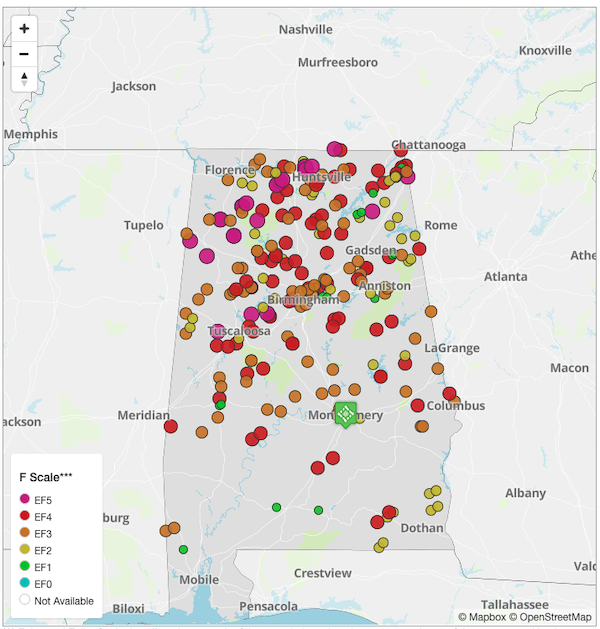
And Bessemer, just like Edwardsville, is in tornado alley:
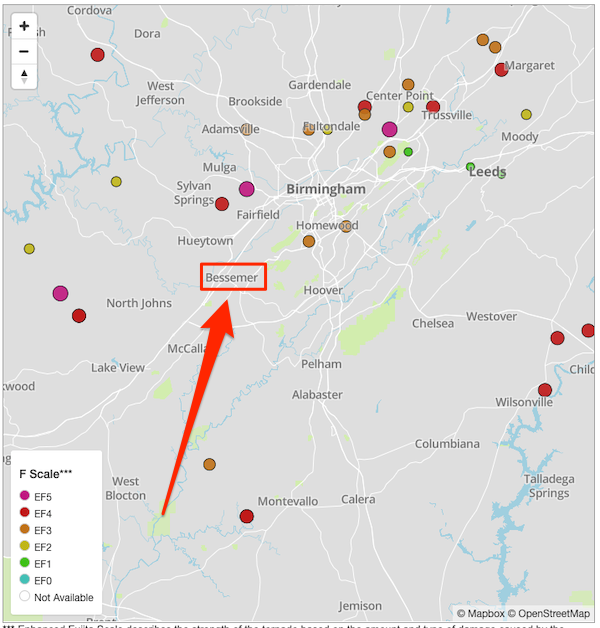
(It is true that Bessemer’s EF-5 was in 1977, its EF-4 in 1956, and its EF-3 in 1967. But just as in Edwardsville, it’s only a matter of time. As the first map, shows, Alabama has tornadoes aplenty.
So, will the Bessemer Amazon workers be adding hardened tornado shelters to their list of demands? How about training, and cellphones on the floor?
APPENDIX 1: Amazon Executives Behaving Badly
Oh, come on (1):
Thoughts and prayers going out to our team in Edwardsville tonight and thank you to all the first responders.
— Dave Clark (@davehclark) December 11, 2021
Oh, come on (2):
Jeff Bezos: "This football when you bring it back down to Earth, is going straight to the Pro Football Hall of Fame."@michaelstrahan: "If I fumble this ball…it's just going to float!"#BlueOrigin
LIVE UPDATES: https://t.co/EoDkjYiYhd pic.twitter.com/BVKpPaobpO— ABC News (@ABC) December 11, 2021
APPENDIX 2: Building Codes for Tornado Shelters
From the Edwardsville Intelligencer:
“We know that the building was constructed according to standard codes and we want to go back and look at every aspect of this,” [Kelly Nantel, director of national media relations for Amazon] said.
As a wise man once said: “The nice thing about standards is that you have so many to choose from.” In any case, the question of what standard the Amazon bathroom storm shelters were built to is, at this point, an open one. (It would be nice if some enterprising reporter could find out.). We do know one thing about building codes in general. Again from the Kansas City Star:
Some engineers interviewed by the Star said building codes for big-box stores need to be strengthened, or the stores should have internal storm shelters when they’re built.
“Unfortunately, the code has become the lowest common denominator,” said Tim Reinhold, chief engineer at the Insurance Institute for Business & Home Safety, which does research for the insurance industry. “Engineers know they are competing for the minimum building code, and so they design right to them.”
Of course, Amazon has all the money in the world, so they don’t have to design to the lowest common denominator. Unless commercial considerations prevail, of course.
Be that as it may, I discovered that the City of Edwardsville uses the International Building Code (2006), which I downloaded. The word “tornado” does not appear. Nor does the phrase “storm shelter.” The individual words “storm” and “shelter” appear in irrelevant contexts (like “storm door” and “bus shelter”). So I am at a loss. Perhaps that enterprising reporter will interview Edwardsville’s code enforcement officer and find out what standard was applied to Amazon’s bathroom shelters; presumably some sort of record was kept by the general contractor, as well.
Until then, all we can do is guess. Here is the standard that FEMA recommends:
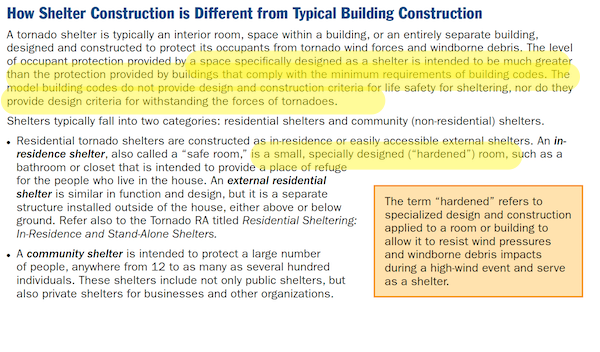
It does seem, however, that even Amazon (and Edwardville Code Enforcement) followed FEMA’s guidance, the “hardened” “specialized design and construction” was insufficient.
There is also ICC 500, a standard produced by the International Code Council (“the leading global source of model codes and standards and building safety solutions”). From Chapter 7 of ICC 500, “Storm Shelter Essential Features and Accessories“:
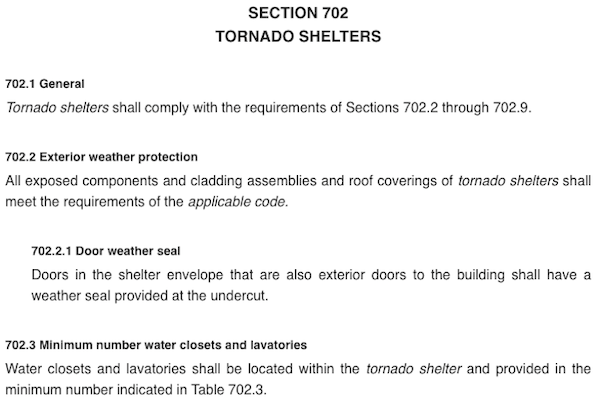
This standard is extremely amusing, first because of 702.2: “All exposed components and cladding assemblies and roof coverings of tornado shelters shall meet the standards of the applicable code,” which I — readers will correct me — interpret to mean that the roof and the walls shall conform to local building codes, whatever they may be. The rest of the section concerns itself with the internals of the shelter, like wiring and lighting. 702.3 is also amusing, because you can see that if Amazon situated the shelter within a bathroom, its compliance with the minimum number of water closets and laboratories is 100%.
Finally, OSHA has this… thing, whatever it is (it doesn’t read like guidance). From “Tornado Preparedness and Response“:
Identifying Shelter Locations
An underground area, such as a basement or storm cellar, provides the best protection from a tornado. If an underground shelter is unavailable, consider the following:
- Seek a small interior room or hallway on the lowest floor possible
- Stay away from doors, windows, and outside walls
- Stay in the center of the room, and avoid corners because they attract debris
- Rooms constructed with reinforced concrete, brick or block with no windows and a heavy concrete floor or roof system overhead
- Avoid auditoriums, cafeterias and gymnasiums that have flat, wide-span roofs.
We don’t know, of course, how the “rooms” were constructed. From the reports of the workers, “a heavy concrete floor or roof system overhead” seems unlikely. Once again, an enterprising reporter could determine conditions on the ground. Or perhaps the nature of the roofs over the bathrooms on the south side could be doped out from aerial photography.


Big mistake encrypting the ticket – that seems to show awareness of liability.
When I worked at Amazon tickets were encrypted when:
(a) sensitive data (PII, trade secrets, etc.) were included.
(b) they discussed security incidents.
(c) they could cause the company embarrassment/liability.
Clearly neither (a) nor (b) obtained.
When a big ticket like that gets encrypted, the news goes round the bush telegraph INCREDIBLY quickly, and it starts hot discussions.
The corporate folks have probably already threatened people openly discussing this on company forums.,
> The corporate folks have probably already threatened people openly discussing this on company forums.
Amazon? Surely not.
They’ll pretend to be subtle, but the message will be loud and clear…
For some strange reason, I am reminded of the Triangle Shirtwaist factory fire. Link:
https://aflcio.org/about/history/labor-history-events/triangle-shirtwaist-fire
In NYC at the time the Triangle Shirtwaist factory fire, there was a strong left-wing in NYC. There were also some conscious struck rich people. It was a combination of things that led social reform in early 20th Century New York. These forces don’t really don’t exist in present day America
Well, we’d a couple 1,300′ deathtrap buildings, where rod joist, concrete, atop corrigated steel construction invited disaster in case of a fire (as did, telling scared workers to stay put?) I’d watched the ginormous EF-5 tear up ACIPCO’s neighbors on April 27, 2011. An M-47 tank was moved into US-31 & a mile and a quarter swath continued from Tuscaloosa to B’Ham. BUT, we’d almost been hit by a flying Saturn (by US Steel/ Fairfield) down in Hueytown, so Bessemer was probably missed? I’m guessing, last time was 2018, just outside Hoover, AL. I’d backed the car into a breezeway & was in the motel’s tub, as the sirens wailed. A firehouse & church got hit, right in the same area. Nothing, fundamentally, will change?
https://m.youtube.com/watch?v=IKfe17QWlt4
https://m.youtube.com/watch?v=KJzJV6pTVC0
Did you know that the owners of the Triangle factory, even after their very small payouts to the victims and their families and the costs of dealing with the factory, the cheap bastards actually made a profit from their insurance payments?
Because of the building’s location in Greenwich Village, the nearby elites of the time were forced to see the piles of the dead, mostly young immigrant women (girls really), which did get some very real safety reforms passed into law.
It only took a 146 deaths and 79 injuries.
There are some good documentaries and books. I can recommend the book Triangle: The Fire That Changed America by David von Drehle
The owners of the Triangle factory, Max Blanck and Isaac Harris, locked exits and hoarded excess scraps fabrics to prevent theft, which made the place a fantastic oven to be, because they wanted to save money.
Jeff Bezos’ Amazon could have cheaply used just some concrete and steel to save some lives, but that also meant spending money.
The more things change…
There are not enough profane words ( and use them way too much as it is in daily life), to describe my thoughts towards Amazon and it’s corporate culture. Forget the swear jar, I need a swear barrel. May Bezos rot in hell.
And Clayton Cope… that is who are the true selfless hero’s in America, Not these executives, the corporate titan Mother******s of the business world. Not the athletes that are worshipped on ESPN. And absolutely not the politicians that pollute and corrupt our society top to bottom.
It’s the day in day out average people you cross paths with everyday.
Apologies for the rant.
Agree 1000%. Everyday people who just do the right thing. They are everywhere. They always have been. Used to be that was who you wanted to be in your community. A part of the goodness of mankind. It is why I love learning local history, quiet good people are always there.
Who will get Jeff Bezos’s pure depravity right up in the face of everyday people? How will someone do it?
If millions of everyday people are somehow forced to see and register what Bezos stands for and what Bezos does to people, will they decide that buying anything more from Amazon is the wrong thing to do, because it helps Bezos keep doing this to people?
The experiment deserves to be run, if someone can figure out how to run it. Get this all up in the face of the everyday people, and then push it all the way up, way up into their nose, to where they will not be able to unsee it and unsmell it no matter how hard they try.
“Unionize Amazon” is a good goal for now, but the best long-range goal would be to shrink Amazon so far down that the hundreds of thousands of jobs it destroyed on its way up can begin to re-emerge.
Then people can start leaving Amazon in their hundreds of thousands and go into those better jobs for less depraved businesses. In a perfect world, this would lead to such world-wide revulsion that all 2-3 billion Amazon customers would all recoil from Amazon at the same time, and never buy anything from Amazon ever again.
“Forget the swear jar, I need a swear barrel.”
I’m going to borrow this quip!
“May Bezos rot in hell.”
I’m feeling a tiny bit gratified amongst the horror that the absolute undiluted awfulness of people like Jeff Bezos (I gave him the moniker Bezosabub here in comments quite a while back) is becoming more apparent to a ever-widening population. May the disgust spread and cover the other billionaire miscreants polluting our republic, next reaching, I hope, Eloi Musk.
In all likelihood, Amazon didn’t build or own that building. Most large corporations do not own most of the properties where they do business, so they can just walk away once the lease is up.
Maybe, but it’s common that many structured are built new (and remodeled ) to the specifications desired by the tenant in a long term lease. If that was the case here Amazon could have demanded safe rooms sized for a full shift of workers to be constructed.
I think there is a good case to be made (but you’d need an old school class action lawyer with deep pockets, that type has been very much hollowed out via concerted and successful efforts to make it super hard to file class action suits) that the (weak) codes presuppose that workers are allowed to leave upon getting tornado warnings (which means tornados have been sighted!). Here in Birmingham, a tornado alley up there with Kansas, government offices, schools, and many private businesses close upon the issuance of a mere warning if the warning time is protracted (as in pretty obvious bad T storms and winds, which are also hazards) to let staff get home and not be on the road in the middle of severe weather, let alone a friggin’ tornado.
Amazon MADE its employees who wanted to leave stay in the face of official warnings. I think they ate a shit ton of liability.
Totally agree with this, except for when its amazon. My company builds big boxes. A lot of them are just big spec buildings to be rented to any company but you know when its amazon coming… They have very specific requirements, it still takes another 4 months to tailor an already move in ready building to amazon. Pretty similar for a fed ex or UPS as well. I used to be in the camp that the already cumbersome building code doesn’t need anything more added but I do agree with what this article said. We might build a 40 million dollar box for amazon, then they put in another 50 million in equipment. Once you have that perspective its easy to justify a storm shelter in the center of the building that I could build for maybe 500k.
Lambert,
I’d be *SHOCKED* if the bathrooms were constructed out of anything other than studs and drywall, unless local code demanded CMU walls and a poured concrete roof which is unheard of.
While the local jurisdiction may have adopted the International Building Code (IBC), typically the state adopts amendments pertinent to local conditions. The New Madrid Fault, centered near St. Louis, for instance, requires unusually robust seismic designs, which would not be automatically included in the IBC. Same with tornado alley zones, where wind load designs may be increased accordingly…or not. You’ll need to find the state and/or local amendments to get the full picture. The structural design of the roof helps walls resist high winds, but the suction loads involved in tornadoes can buckle large roof areas and eliminate the lateral protection. It seems unlikely that the toilet rooms were designed as storm shelters, but that would be subject to final investigations on the ground, but would have been the most cost-effective way to protect building occupants. I make these observations as a licensed (MN) architect, who has worked on large warehouse designs around the country.
Thanks, this is good info. Of course, the Amazon spokesperson’s “standard codes” is, therefore, even more hooey than I orginally thought it was.
“…minimum number of water closets and laboratories…”
Please don’t give Amazon any ideas.
“You want to use the bathroom? Well, sure… if you do a little experiment for us at the same time.”
Ha – there was a period of some years after Amazon opened its first high-rises (Doppler and Day 1) in South Lake Union when the company was in violation of OSHA bathroom provisions. There were the same number of male and female toilets on each floor, but the preponderance of male employees meant that there were only around 60% of the required number for men.
This spawned a really lengthy trouble ticket, which Amazon tried to ignore, but eventually they promised to look into it. Crickets. More back and forth, with Amazon doing nothing, until in the end they said that discussion was closed and that was the end of it. I doubt it ever got resolved.
There is another cold front tomorrow. These things are predicted in advance —
NWS Storm Prediction Center @NWSSPC 1h
For tomorrow afternoon and evening: a fast-moving band of strong to severe t-storms may be capable of damaging winds & a couple of tornadoes across IA & southern MN. Remain weather aware by checking in with a trusted source of weather information throughout the day. #IAwx #MNwx
Amazon is simply acting in a traditional manner, just ask the folks at P.G.& E. if you don’t believe me.
Please do not assume my comments below in any way defend what happened at the warehouse and Amazon’s response.
I looked at the satellite view of the Amazon warehouse on Google just now. I counted roughly 20 additional buildings that look to provide the same function as the Amazon one.
Are all of these constructed in the same fashion? Do all of these meet the same building codes for that location?
Since the focus of the your piece seems to be the poor choice in construction due to the high chance of tornadoes, perhaps you should begin you piece wondering why the local government is obviously totally indifferent to worker safety. Amazon may or may not have built to code, I’m sure someone will investigate to make a definite decision. If they did build to code, then your ire and those of others should be directed towards the local government. They are the ones, each and every one of them, who contributed to the deaths and injuries.
Lay the blame where it belongs. Amazon is a crappy place to work but if the building was built to code, then you have no cause to blame them for it falling down. Blame the people who wrote the building codes and enforce them. Bad building codes gets you dead people. Blame the people in that town that allow the poor building codes to continue year after year.
That’s true and it is not. It is well know how gargantuan corporations will get exceptions and the like to local codes if they agree to move there. Hell, local authorities will go so far as to build roads and run power & water to those new facilities for free. Remember that Foxconn building in Wisconsin? Scott Walker ‘exempted the firm from Wisconsin’s environmental rules regarding wetlands and streams’ and ‘rolled back air pollution limits in the area of the plant, overruling objections of Environmental Protection Agency staff.’ And that is how it works.
https://en.wikipedia.org/wiki/Scott_Walker_(politician)#Foxconn_agreement
I should mention that when this post started off by saying “It’s an efficient and low-cost building system, but it’s only stable when all the connections are working.” When you think about it, it is like a dam wall. It’s strength is in its unity and when one part fails, the whole dam fails. Same with this Amazon building but if there was any justice, there should be yellow tape around the whole area and the place declared to be a crime scene. But in the same way that JBird4049 pointed out that the owners of the Triangle factory made a profit after the fire, I would expect Bezos to make a profit from his insurance policies. You can bet that a good politician could use the upcoming midterms to make worker safety in Tornado Alley an issue for Amazon but I believe that both the Republicans and Democrats will work together to de-fang this issue.
See above. You are parsing the liability incorrectly.
Amazon threatened them to REMAIN inside said shitty buildings in the face of government warnings to go someplace safe, which was clearly NOT said shitty buildings.
This guy is not Bob
There’s a contradiction here.
Mark Sites says that “the concrete panels are formed on the ground, like a tall skinny rectangle. When the reinforced concrete has reached the needed strength a crane is used to tilt the panels up and ‘stack’ them along the exterior steel frame. The steel framing of the building is what carries the wind loading on the walls.”
Actually, for quality control and curing reasons, the concrete panels are produced in a temperature controlled factory, trucked to the site, then erected with a crane. There is a concrete footing which, if I remember correctly, they are bolted to. I’ve watched the buildings being erected and, except at the building corners, I believe there is no “exterior metal frame”.
The picture verifies the lack of exterior steel framing. It shows the panels on the near (west) side blown down in the outward direction and there are no signs of a steel frame on the upward facing (inside) of the downed wall. Likewise, the section of the west wall still standing shows no indication of steel supports on the outside. The concrete panels are self-supporting.
Lambert’s comments that “If you look back at the picture of the post-tornado warehouse above, you will see the steel framing still standing, amidst the rubble of the walls and the roof.” Actually, the thin interior steel roof supports still standing are not on the exterior wall, they are regularly spaced in the building’s interior and are not designed to resist lateral loads; they are there to support the roof. Look up next time you are at Walmart or Home Depot; they have the same thin steel posts.
Finally, one of the survivors said he was in the bathroom and was pinned under a large piece of concrete. There is no concrete in the roof so he was probably in a bathroom along the exterior east wall that collapsed, where offices and bathrooms were probably put to centralize plumbing and allow for windows (note the truck bays and windows on the surviving part of the west wall). That tells me the bathrooms were not designed as shelters. They were used as shelters because they had no windows.
In my opinion, in areas subject to high winds (the Atlantic coast and the tornado belt), the bathrooms or survival spaces need to be away from the concrete wall panels. But that would limit the infinite flexibility tenants want in the “open space” that they lease. The same “We want no pillars, permanent walls or triangulated lateral supports in our open rental space.” was part of the reason why the World Trade Center was built with all the load on the exterior walls… with tragic results.
In 2012, I was at a brand new large utility’s transmission and distribution control center in the same region hit by the tornadoes. The control center is the “brains” of the system; there is always another separate redundant control center, usually a legacy facility in a downtown, but with near-identical hardware and software.
The VP told me it was constructed to withstand EF-5, I believe. I don’t know if historical tornado paths have a target on the facility; it would be interesting to look up. But those buildings often are unidentified on maps. But I clearly recall he said that the wall panels were poured and cured on site before being hoisted into place. If the panels were manufactured off site, they’d have to fit on a flatbed trailer and probably couldn’t exceed 8.5 feet. The panels were much wider that 8 feet and probably 30 feet tall. I seriously doubt it would be economical use an off-site construction method, given the limitations.
Concrete beams, posts, pilings and transmission poles are manufactured off-site under controlled curing.
I don’t know if NERC, the NGO regulator for transmission, or FERC/DOE/Homeland Security have defined building standards for electric utility operation centers. Perhaps they do. They surely have imposed all sorts of check-the-box security theater measures, which only become more pernicious.
I have hauled pre-cast concrete panels on a flatbed truck. Have hauled panels over 11 feet wide, just need an over-dimensional permit and pilot cars due to the extra width. 40 foot long panels are common – no problem on a 48-foot trailer.
The buildings I hauled to were for cold storage for fruit – they stand them up with a crane, then weld them together with steel plates which are embedded in the concrete.
There are multiple types. Precast buildings are as you say, cast in panels offsite. Korte Construction has a page detailing form in place tilt up construction, which is what was done multiple sites around st. louis area:https://www.youtube.com/watch?v=MQN33d5GXrQ
These commerce parks have been going up through most of my adult life in this area, and I don’t recall seeing many trucks hauling precast panels.
The building I used to work in definitely was built form-in -place, I saw it being erected.
It was smaller than Amazon’s, though not much. We had, at one time, more than 100 people working there.
Probably 20 could squeeze in each bathroom. (1 mens, one women’s). Offices had a one-holer. The BRs were of block construction (walls) but the ceiling was suspended from above, and was steel stud and drywall.
This Gateway Commerce operation hosts Unilever, Hershey, P&G, Dial, and (previously?) Kraft/Heinz among the huge warehouses. That building is just like the other 200 in St. Louis metro area. Let me know if you hear of any with tornado shelters. Real shelters for hundreds of people at once? NaGaHappen…
Nothing unique about AMZN here.
I don’t understand the significance of how AMZN learned of the incident from media reports after they were getting reports of network outages. What does that even mean? None of them had a cell phone?
AmZN has much to answer for, but this is normal for warehouses.
“We want no pillars, permanent walls or triangulated lateral supports in our open rental space.” was part of the reason why the World Trade Center was built with all the load on the exterior walls… with tragic results.”
while the 9-11 Commission made this statement, I have read and seen video of the construction that shows a rectangular array of large interior pillars, thus making the 9-11 Commissions conclusions even less reliable.
One guy tweeted his girlfriend before he died saying that Amazon would not let them leave-
https://twitter.com/MorePerfectUS/status/1470513075489054720
Apparently that facility dealt with ‘last mile’ shipments. Maybe somebody should check the logs to see at what point Amazon actually stopped sending their drivers out to do deliveries as that tornado was approaching. Apparently there was plenty of warning so would they have been following it on radar maps to see how many deliveries they could get out first?
It may not be particularly relevant but we have an Amazon warehouse in our town and I seem to recall when it was built the articles said it was leased. Trying to nail down the facts via DDG seems difficult but I did find this one link at least from 2019
http://www.dailynews.com/2019/11/16/commercial-real-estate-mailbag-does-amazon-own-or-buy-warehouses/
Of course as the quote indicates Amazon doesn’t just go find an empty building and they are purpose built for Amazon and to Amazon’s specfications. And Amazon is legally responsible for everything that goes on inside that building.
But it may be that there are other parties involved. Osha in any case is investigating.
Why not look into the construction standards Amazon’s data centers are built to?
My late mother was born and spent her early girlhood in Oklahoma, tornado alley #1. She came from farm stock, and they had root cellars. Some of the stories she told were hair raising. One thing I clearly recall. She said if the twister looks like it’s standing still, take shelter immediately! It’s either coming straight at you or going straight away. If it looks like it’s going sideways, you may be safe. Of course, if it’s at night, all bets are off. One seeks shelter, no matter what! She was born in the 1930s so they did not have the weather tech we have now. I also lived in Birmingham, AL for a couple of years and clearly recall the funnel clouds in storms. Hairy, scary Mother Nature, for sure. I hope they hang Bezos, but it’s not a perfect world, alas.
Fabulous research. Great detail. Thank you.